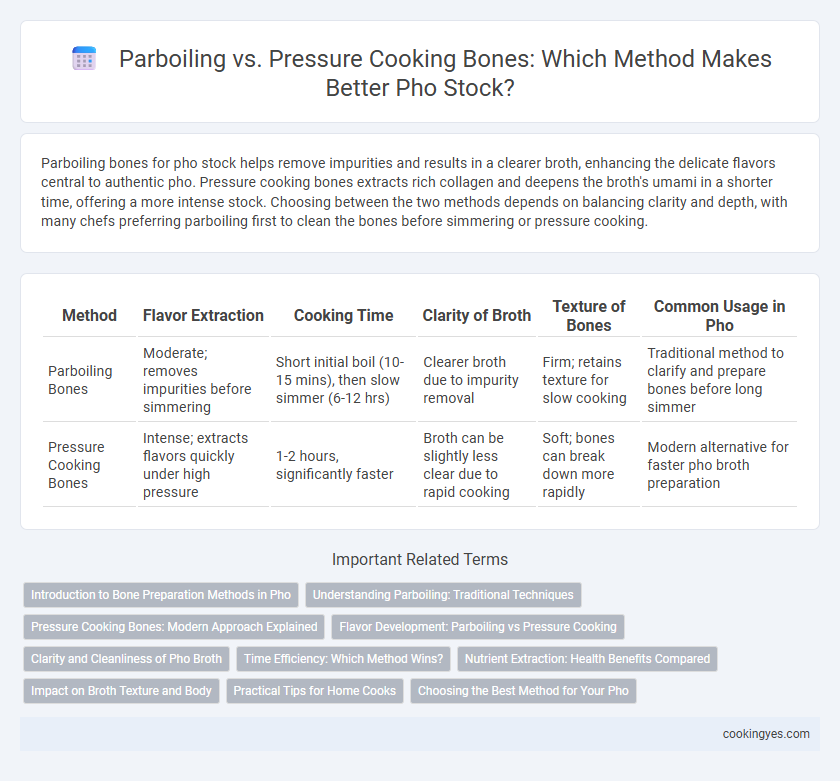Parboiling bones for pho stock helps remove impurities and results in a clearer broth, enhancing the delicate flavors central to authentic pho. Pressure cooking bones extracts rich collagen and deepens the broth's umami in a shorter time, offering a more intense stock. Choosing between the two methods depends on balancing clarity and depth, with many chefs preferring parboiling first to clean the bones before simmering or pressure cooking.
Table of Comparison
| Method | Flavor Extraction | Cooking Time | Clarity of Broth | Texture of Bones | Common Usage in Pho |
|---|---|---|---|---|---|
| Parboiling Bones | Moderate; removes impurities before simmering | Short initial boil (10-15 mins), then slow simmer (6-12 hrs) | Clearer broth due to impurity removal | Firm; retains texture for slow cooking | Traditional method to clarify and prepare bones before long simmer |
| Pressure Cooking Bones | Intense; extracts flavors quickly under high pressure | 1-2 hours, significantly faster | Broth can be slightly less clear due to rapid cooking | Soft; bones can break down more rapidly | Modern alternative for faster pho broth preparation |
Introduction to Bone Preparation Methods in Pho
Parboiling bones for pho stock involves briefly boiling them to remove impurities and blood, resulting in a clearer broth with a cleaner flavor. Pressure cooking bones extracts collagen and minerals more rapidly, producing a rich, gelatinous stock in a shorter time. Both methods affect the texture and clarity of the pho broth, influencing the final taste and mouthfeel of the dish.
Understanding Parboiling: Traditional Techniques
Parboiling bones for pho stock removes impurities and blood, resulting in a clearer, cleaner broth essential for authentic Vietnamese flavor. This traditional technique involves boiling bones briefly, discarding the water, and rinsing bones before simmering, which preserves the delicate umami while reducing cloudiness. Understanding parboiling's role highlights its importance over pressure cooking, which can extract flavors faster but may produce a murkier broth lacking the nuanced clarity prized in pho.
Pressure Cooking Bones: Modern Approach Explained
Pressure cooking bones for pho stock significantly reduces cooking time from traditional hours to under two hours while extracting rich collagen and deep umami flavors essential for authentic pho broth. The high-pressure environment breaks down connective tissues more efficiently, resulting in a clearer, more gelatinous stock with enhanced nutrient content. This modern approach preserves delicate aromatics like star anise and cinnamon, intensifying the complex flavor profile central to Vietnamese pho.
Flavor Development: Parboiling vs Pressure Cooking
Parboiling bones for pho stock helps remove impurities and results in a cleaner, more subtle broth flavor. Pressure cooking bones extracts deep, rich flavors quickly, intensifying umami and collagen release for a gelatinous texture. While parboiling emphasizes clarity and lightness, pressure cooking enhances depth and complexity in the pho broth.
Clarity and Cleanliness of Pho Broth
Parboiling bones for pho stock removes impurities and blood, resulting in a clearer and cleaner broth essential for authentic flavor. Pressure cooking intensifies extraction but can release excess fats and sediments, leading to a murkier appearance. For the clearest, cleanest pho broth, parboiling is the preferred method before slow simmering.
Time Efficiency: Which Method Wins?
Pressure cooking bones for pho stock significantly reduces cooking time, typically achieving rich, gelatinous broth in 2 to 3 hours compared to the 6 to 8 hours required for parboiling. This method not only speeds up collagen and marrow extraction but also intensifies flavors more rapidly, enhancing time efficiency without sacrificing broth quality. Pressure cooking proves superior for chefs aiming to prepare authentic pho stock quickly and consistently.
Nutrient Extraction: Health Benefits Compared
Parboiling bones for pho stock allows gradual nutrient extraction, preserving delicate minerals like calcium and magnesium for enhanced bone health. Pressure cooking breaks down collagen rapidly, increasing gelatin content that supports joint health and digestion, but may reduce some heat-sensitive vitamins. Choosing between methods depends on prioritizing specific nutrients: parboiling favors mineral retention while pressure cooking maximizes collagen extraction for superior pho broth nutrition.
Impact on Broth Texture and Body
Parboiling bones for pho stock results in a clearer broth with a lighter texture, as it helps remove impurities and excess fat before simmering. Pressure cooking extracts more collagen and marrow quickly, producing a richer, thicker broth with a fuller body, but may cause slight cloudiness. The choice between parboiling and pressure cooking directly affects the balance between broth clarity and mouthfeel essential for authentic pho.
Practical Tips for Home Cooks
Parboiling bones for pho stock removes impurities and results in a clearer broth, while pressure cooking extracts deeper flavors faster, ideal for busy home cooks. Start by blanching bones in boiling water for 10 minutes to remove scum before simmering for hours or use a pressure cooker to reduce cooking time to about 1.5 hours with similar flavor intensity. Skimming foam during both methods ensures a cleaner stock, and adding aromatics like ginger and star anise enhances the authentic pho taste.
Choosing the Best Method for Your Pho
Parboiling bones for pho stock removes impurities and results in a clearer broth, enhancing the traditional flavor profile crucial for authentic Vietnamese pho. Pressure cooking bones accelerates collagen extraction, yielding a rich, gelatinous broth in less time, ideal for busy kitchens seeking efficiency without compromising depth. Selecting between parboiling and pressure cooking depends on balancing clarity and cooking time to achieve the characteristic aroma and texture of genuine pho stock.
Parboiling bones vs pressure cooking bones for pho stock Infographic

 cookingyes.com
cookingyes.com